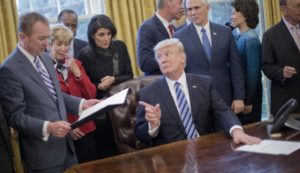by WorldTribune Staff, March 14, 2017
The U.S. government wants you – to help make it great – and small – again.
Thanks to the new “Comprehensive Plan for Reorganizing the Executive Branch” executive order issued on March 13, President Donald Trump said “all Americans will be able to submit suggestions and ideas on how to make government work better for them.”

“Based on this input, we will develop a detailed plan to make the federal government work better, reorganizing, consolidating and eliminating where necessary. In other words, making the federal government more efficient and very, very cost productive. So we’re going to do something, I think, very, very special,” said the president.
Director of the Office of Management and Budget Mick Mulvaney will head up the effort, the Washington Examiner reported.
Grover Norquist, president of Americans for Tax Reform, lauded Trump’s new order.
“Too many politicians come into Washington promising to drain the swamp and quickly decide it is a hot tub. Trump has decided to act quickly before he or his administration got seduced into thinking ‘slow and stupid’ is the acceptable norm.”
The Trump administration spotlighted some of what it is up against:
- Under President Barack Obama, the national debt grew by 88 percent from $10.6 trillion on Jan. 20, 2009, to $19.9 trillion on Jan. 19, 2017.
- Every child born today inherits over $61,000 in debt.
- In April 2016, the Government Accountability Office (GAO) reported that the Executive Branch and Congress failed to fully address a majority of the government fragmentation, overlap, and duplication identified by the GAO.
- The Executive Branch has failed to fully follow through 53 percent of the time, failing to act on 243 of the 459 identified instances of bureaucratic duplication and waste.
- Congress has failed to fully follow through 62 percent of the time, failing to act on 53 of the 85
identified instances of bureaucratic duplication and waste. - In 2016, the GAO identified 92 more instances of duplication and waste.
